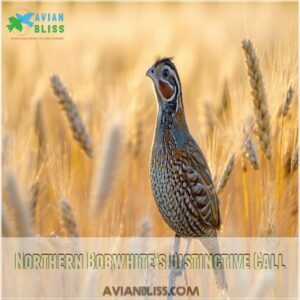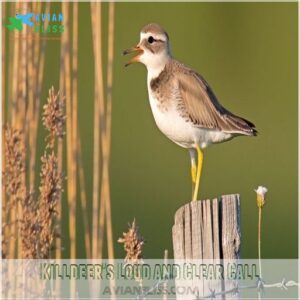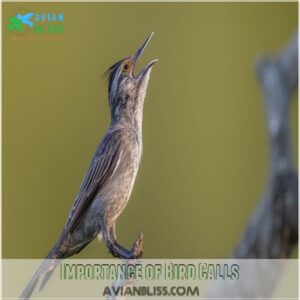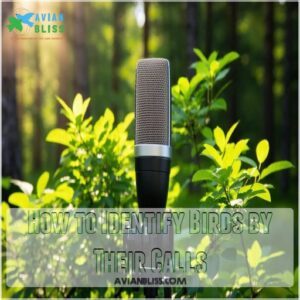This site is supported by our readers. We may earn a commission, at no cost to you, if you purchase through links.

Take the Eastern Phoebe, whose repetitive "fee-bee" call is as reliable as your morning alarm, or the haunting sound of the Poorwill that seems to echo through the night.
These calls aren’t just for show; they’re essential for survival, helping birds find mates, stake out territories, and even warn others of predators.
Curious about which calls belong to which birds? There’s a whole chorus waiting to be explored.
Table Of Contents
- Key Takeaways
- Unique Bird Calls Explained
- Bird Species With Unique Calls
- Importance of Bird Calls
- Birds With Unique Vocalizations
- Bird Call Identification Techniques
- Bird Adaptations and Unique Calls
- Famous Birds With Unique Calls
- Bird Call Variations and Dialects
- Conservation Efforts and Unique Bird Calls
- Birding and Unique Calls
- Frequently Asked Questions (FAQs)
- Why do some birds have unique calls?
- What is an example of a distinctive bird call?
- Do bird calls sound like names?
- What are bird sounds?
- What is a bird call?
- How do birds get their names?
- What bird has the most unique call?
- Which bird has unique voice?
- What bird has many different calls?
- Which bird has the best call?
- How do birds learn their calls?
- Why do bird calls vary regionally?
- Do all birds have unique calls?
- What are the quietest bird calls?
- Can bird calls be mimicked by humans?
- Conclusion
Key Takeaways
- You’ll discover that bird calls aren’t just pretty sounds; they’re essential tools for survival, enabling communication, mate attraction, and territory defense.
- Certain birds, like the Northern Bobwhite and Eastern Whip-poor-will, have distinctive calls that serve as nature’s identifiers, offering clues about their habitats and behaviors.
- Understanding bird calls can enhance your birdwatching experience, allowing you to identify species by sound and appreciate their unique vocalizations.
- Bird call variations and dialects can reveal regional adaptations, similar to human accents, enriching your appreciation of avian diversity and communication.
Unique Bird Calls Explained
When you’re out in nature, listening closely to birds’ unique calls can be both fascinating and enlightening.
Understanding why these tunes vary helps you identify species, as each one uses distinct sounds for communication and survival.
Why Birds Make Unique Sounds
Birds make unique sounds that serve as their survival toolkit, offering them evolutionary advantages. Consider these reasons:
- Communication methods: A chatty bird is a connected bird.
- Mating rituals: Serenades aren’t just for rom-coms!
- Territorial defense: Squawking keeps the neighbors at bay.
- Predator avoidance: Stay safe with stealthy tunes.
- Individual identification: Each bird’s call is its signature tune.
Role of Bird Calls in Identification
Think of bird calls as nature’s fingerprints—essential for bird identification.
These unique bird calls help you distinguish species without needing sight, tapping into bird sound recognition.
Just like a musician tuning in to specific notes, mastering bird call identification adds layers to your birdwatching adventures, enhancing your experience and connection to these extraordinary creatures.
Types of Unique Bird Calls
Let’s explore the amazing variety in bird calls! You’ll find simple whistles, complex songs, and even harsh screeches.
Call complexity varies greatly depending on species, with some exhibiting impressive call mimicry.
Bird call evolution has shaped this diversity, leading to unique calls that aid in communication, mate attraction, and territory defense.
Regional variations and dialects further add to the richness of bird vocalizations. Studying these differences provides fascinating insights into bird species.
Bird Species With Unique Calls
You’re about to discover the fascinating world of birds that serenade with calls as unique as their names, from the cheerful Northern Bobwhite to the eerie Poorwill.
Each of these avian musicians has adapted its call for survival in its natural habitat,
creating a symphony that intrigues birdwatchers and scientists alike.
Northern Bobwhite’s Distinctive Call
Imagine hearing the Northern Bobwhite’s call – it’s like nature’s way of saying "bob-white!" This unique sound resonates across fields and forests, making it memorable.
Here’s what you should know:
- Regional Variations: Their calls vary across different areas.
- Mimicry: Sometimes, other birds mimic their distinctive tune.
- Seasonal Changes: Their calls adapt with the seasons, reflecting changes in behavior and territory.
Killdeer’s Loud and Clear Call
A Killdeer’s call is as striking as its habitat versatility.
You’ll often hear its loud "kill-deer" sound echoing across fields or parking lots.
This distinct call plays multiple roles in its life: from startling predators and protecting nests to interacting socially with other Killdeers.
Fascinatingly, these calls can vary regionally, showcasing evolutionary adaptations and the rich tapestry of bird sound identification.
Poorwill’s Haunting Call
Just like the Killdeer’s loud calls, the Poorwill’s haunting cry echoes through the night, making it an eerie serenade in the desert air.
Known for its nocturnal habits, the Poorwill’s call isn’t just a sound but a mysterious signal wrapped in evolutionary history.
These unique calls help in defining territories, attracting mates, and even conserving energy.
Eastern Phoebe’s Repetitive Call
Eastern Phoebes are known for their repetitive "fee-bee" song, a melodic reminder of nature’s rhythms.
These vocalizations are a key aspect of phoebe behavior, often signaling the bird species’ habitat preferences near water or wooded areas.
Phoebe conservation efforts benefit from recognizing these unique calls, which help identify their presence, aiding in bird call recognition and study.
Eastern Whip-poor-will’s Continuous Call
Listening to an Eastern Whip-poor-will’s call is like hearing a never-ending serenade of the night woods.
This bird’s continuous whistle echoes through forests, creating a soothing yet mysterious backdrop.
You can find products that mimic the Eastern Whip-poor-will sound effects Whip-poor-will sound products.
Their unique vocal mimicry and call variations intrigue bird enthusiasts.
Although their conservation status is stable, understanding their calls helps protect this fascinating species and enriches our appreciation for unique bird sounds.
Importance of Bird Calls
You’ll find that bird calls aren’t just pretty sounds; they’re essential for a bird’s survival, influencing everything from finding mates to defending territory.
Understanding these calls helps us appreciate the complex social lives and survival strategies of different bird species, revealing a hidden world of communication.
Bird Calls and Avian Behavior
When you hear bird songs filling the air, you’re witnessing avian behavior at its finest. Bird calls often serve four key purposes: Birds also use these sounds to maintain contact with their flock or family members, as seen in contact calls between family members.
- Mating calls ignite romance.
- Alarm signals alert others to danger.
- Territorial defense warns intruders.
- Vocal mimicry confuses predators.
These fascinating sounds reveal secrets of bird species, showing how bird song enriches their lives.
Role of Bird Calls in Social Interactions
Bird calls aren’t just tunes; they’re all about connection.
Each chirp and tweet tells a tale of territory defense, social hierarchy, or a call to flock together.
Think of them as nature’s group chats, whether it’s a song of courtship or a shrill alarm.
Birds, like neighbors at a barbecue, have their own unique way of communicating.
How Bird Calls Affect Habitat Selection
Ever wondered why certain bird songs echo in specific spots?
Bird calls play a key role in habitat selection.
They help define territory, ensuring birds find their "home sweet home."
Call diversity and acoustic niches prevent sound masking by neighbors.
Whether you’re a fan of the bird sound library or just curious, understanding bird call analysis opens doors to avian life.
Bird Calls and Mating Rituals
You know how every neighborhood has that one Romeo?
Birds aren’t much different. They use songs as part of their mating rituals, crafting serenades that would put Romeo to shame.
These vocalizations signal to potential mates that they’ve got the right stuff.
With courtship calls, birds showcase:
- Territory ownership
- Genetic quality
- Readiness to mate
- Species identity
Birds With Unique Vocalizations
You’re about to discover fascinating birds that entertain us with their unmistakable calls, each with a purpose and story.
From the enchanting "whip-poor-will" echoing through the night to the cheerful "bob-white" call gracing sunny fields, these vocalizations reveal secrets of avian life and offer hints for identifying these remarkable species.
Characteristics of Unique Bird Calls
Many bird calls are surprisingly complex.
Call structure, encompassing pitch, rhythm, and timbre, varies greatly between species.
Call function serves many purposes—mating, territorial defense, and chick communication.
Call evolution shapes these sounds over time, adapting to specific environments and social needs.
Understanding call variation helps us appreciate the incredible diversity in avian communication.
A bird sound database can aid your exploration.
Examples of Birds With Unique Calls
Let’s explore a fascinating squad of birds with voices as unique as their plumage. These feathered vocalists include:
- Northern Bobwhite: Famous for its crisp "bob-white" call.
- Killdeer: Impresses with a loud "kill-deer" sound.
- Poorwill: Known for its haunting "poor-will" voice.
- Among birds with notable vocalizations, the Northern Mockingbird stands out for its mimicry skills in city streets avian mimicry masters.
- Eastern Whip-poor-will: Its continuous chant enchants listeners at twilight.
Each species boasts its own signature sound, adding depth to bird call communication and our natural soundscape.
How to Identify Birds by Their Calls
Ever tried using bird call apps like a sonic Sherlock Holmes?
These tools and field guides can unravel the mystery of bird sounds.
Record calls to compare with a library or practice listening in nature.
Avoid common mistakes by focusing on patterns and rhythms.
Analyzing the nuances of bird species calls transforms identification from guesswork to skillful art.
Bird Call Identification Techniques
When you’re identifying bird calls, you’ll need both your ears and your eyes, as some birds have calls as quirky as their plumage.
You might find yourself consulting apps or recordings, turning your birdwatching into something like a nature-themed trivia game.
Visual Vs. Auditory Identification
In birdwatching, the age-old debate of sight versus sound can make or break your experience.
While field guides provide visual cues, bird song apps reveal hidden serenades.
You can even find helpful tools like bird sound identifiers to help you decipher their unique songs.
Recognizing bird calls can seem tricky, but combining visual observation with auditory skills broadens your understanding.
Balancing these elements helps masterfully classify bird species by their distinct names and unique sounds.
Tips for Recognizing Unique Bird Calls
When you’re out enjoying nature, listening closely is key to recognizing unique bird calls.
These fascinating sounds often reflect a bird’s personality and environment.
Pay attention to call variations; some birds are skilled mimics.
By identifying calls by habitat and using a bird call library, you’ll start distinguishing bird species like a seasoned pro in no time.
Using Technology for Bird Call Identification
Exploring bird call apps and AI identification can transform your birding experience.
Sound recording devices capture elusive calls, while citizen science apps build vast bird call libraries.
Engaging in bird sound analysis helps classify bird species efficiently.
With data analysis tools, you’re part of a community that uncovers nature’s secrets—turning your backyard birdwatching into a scientific adventure.
Bird Adaptations and Unique Calls
You’ll discover how birds’ unique calls aren’t just pretty sounds; they’re essential adaptations for survival, shaped by natural selection over countless generations.
These specialized vocalizations help birds attract mates, defend territories, and even avoid becoming someone else’s dinner, highlighting the fascinating interplay between sound and survival in the avian world.
How Unique Calls Aid in Survival
Ever wonder how those unique bird calls keep our feathered friends safe? It’s like having a personal alarm system.
Birds use calls to:
- Attract mates – charming tunes set the stage for romance.
- Warn others – a shout-out about approaching danger.
- Defend territory – staking their claim with vocal prowess.
These avian vocalizations are key to survival strategies.
Camouflage and Unique Bird Calls
A bird’s unique call isn’t just about attracting mates; it’s a clever part of nature’s strategy.
By understanding the differences between songs and calls, birds can adapt their vocalizations to suit their environment, combining seamlessly with their camouflage to create a hidden world where birds blend both visually and vocally into their habitats.
This magical mix helps them survive, allowing birds to thrive unnoticed, evading dangers while serenading the skies with their distinctive calls.
Unique Calls and Predator Avoidance
Some birdcalls aren’t just for show—they’re survival tools straight out of nature’s playlist.
- Mimicry: Imitating predator calls to confuse threats.
- Sound Localization: Altering call direction makes it harder for predators to pinpoint them.
- Alarm Calls: Warning others of approaching danger.
- Call Variation: Changing pitch or tone to stay unpredictable.
- Predator Recognition: Distinct calls help identify different threats.
Famous Birds With Unique Calls
You’ve probably heard the enchanting calls of birds like the whippoorwill or the bobwhite, and maybe even wondered what makes them so distinct.
These birds, with their unique vocalizations, add a delightful soundtrack to nature, marking their territories and communicating through sounds that are often more recognizable than their actual appearances.
The Whippoorwill’s Call
Picture yourself in a dense forest at dusk, where the Whippoorwill’s call echoes eerily through the trees.
This bird’s distinctive, rhythmic chant is more than a serenade; it’s evolved perfectly for twilight, blending into its habitat’s soundtrack.
You might even mistake it for mimicry, though it’s an unmistakable hallmark of its mating ritual.
Isn’t nature’s soundscape fascinating?
The Bobwhite’s Distinctive Call
The Northern Bobwhite’s call, a cheerful "bob-white" whistle, is both musical and distinctive. This call plays a critical role in species communication and identification.
- Bobwhite call evolution: It’s adapted for open spaces.
- Bobwhite call variations: Regional differences occur.
- Bobwhite call mimicry: Imitators exist among birds.
- Bobwhite call threats: Habitat loss impacts it.
- Bobwhite call conservation: Essential for population monitoring.
The Chuck-will’s-widow’s Unique Call
Many consider the Chuck-will’s-widow’s call one of nature’s most enchanting bird sounds.
Its name perfectly mimics its distinctive, drawn-out call.
This nocturnal bird’s vocalizations show fascinating call variations across its range, hinting at call evolution and potential call mimicry.
Understanding this unique bird and its calls contributes to our appreciation for biodiversity.
The Chuck-will’s-widow’s song holds a certain cultural significance in some areas.
Bird Call Variations and Dialects
You might be surprised to learn that bird calls aren’t just about making noise; they can vary regionally like accents in human speech, adding a layer of complexity to avian communication.
These subtle differences, or dialects, play a key role in how birds interact and could even change over time due to environmental influences or migration patterns.
Regional Variations in Bird Calls
As you explore the avian world, you’ll notice that bird calls aren’t just consistent chirps; they’re influenced by geography.
Birds, much like us, have regional accents shaped by environmental factors and migration patterns.
These sounds differ as birds adapt to diverse habitats, showcasing nature’s unique dialects.
It’s a symphony of diversity, revealing how little tweaks in sounds mark evolutionary adaptations.
Dialects and Unique Bird Calls
Ever heard how birds from different regions sound a bit like they’re speaking with accents?
These geographic dialects in bird calls mirror human language quirks.
Just like picking up a friend’s catchphrase, birds can learn calls, with mimicry adding fun twists.
Understanding these unique calls among bird species can reveal fascinating insights into bird language and their social connections.
How Bird Calls Change Over Time
Bird call evolution is as dynamic as nature itself.
Ever wonder why bird calls change over time?
Seasonal shifts and geographic dialects play a role.
Birds also use songbird learning techniques to adapt their vocalizations to their environment.
Environmental factors influence avian vocalizations, shaping unique calls.
Human impact can alter bird communication pathways, leading to adaptations.
Some bird species exhibit variations depending on region, showcasing the beauty of evolving bird calls.
Conservation Efforts and Unique Bird Calls
You might think bird calls are just pretty background sounds, but they play a key role in conservation efforts.
By identifying birds through their unique calls, researchers can more easily track and protect species.
Ensuring that even the sneakiest birds aren’t forgotten.
Role of Bird Calls in Conservation
In the world of conservation, bird calls are like nature’s broadcast signals, vital for mapping habitats and understanding species diversity.
By recording avian vocalizations, scientists can track changes in bird populations and habitats over time.
It’s like tuning into nature’s own podcast, where each unique call informs conservation efforts to preserve these feathered storytellers and their vibrant ecosystems.
How Unique Calls Aid in Species Identification
A bird’s unique call is its fingerprint, a key clue for identification.
Think of it like a secret code; each species has its own distinct call patterns, from the Northern Bobwhite’s "bob-white" to the Killdeer’s insistent "kill-deer."
Field guides and online resources catalog these sounds, allowing you to match a call to a species.
Geographic range further refines your search.
Learning to recognize these unique calls deepens your appreciation for the amazing diversity of bird species.
Conservation Status of Birds With Unique Calls
Unearthing the charm of unique bird calls leads us to understand their conservation status. These distinctive voices face threats from habitat loss and mimicry issues.
Conservation strategies are essential, as citizen science promotes monitoring through bird call databases.
You might find that threatened species with unique calls demand our attention to preserve their tunes for future generations:
- Habitat loss impact
- Conservation strategies
- Call mimicry
- Citizen science
Birding and Unique Calls
When you’re out birdwatching, recognizing unique calls adds a new dimension to your experience, letting you identify birds even when they’re hidden.
Just like learning to recognize a friend’s voice in a crowded room, honing your ear for unusual bird sounds can make your outdoor adventures both more rewarding and more fun.
Tips for Birdwatchers
Moving from conservation efforts, let’s chat birdwatching.
Gear up with lightweight binoculars for comfort.
Know your habitats to better spot those elusive species.
Use Bird identification tools to aid in species recognition.
Use bird call apps to identify unique calls without a fuss.
Respect birdwatching etiquette by avoiding loud noises.
Remember, birdwatching is a bit like fishing; patience pays off when species recognition meets memorable experiences.
How to Record and Identify Unique Bird Calls
Got your binoculars and ready for more?
To capture and identify unique bird calls, start with: Bird call apps for quick ID.
Handy field guides to compare.
A trusty recorder for crisp nature sounds.
Learn how to identify a bird’s habitat through its calls by analyzing its soundscape characteristics.
Mimic their call mimicry to refine your skills.
Remember birdwatching etiquette—being part of nature, not the noise!
Frequently Asked Questions (FAQs)
Why do some birds have unique calls?
Birds have unique calls to communicate specific messages like territory claims and mate attraction.
These distinctive sounds help identify species, deter rivals, and guarantee survival by adapting to their environment’s acoustic properties.
What is an example of a distinctive bird call?
Take the killdeer, for example.
This bird’s call sounds like it’s shouting "kill-deer!"
You’ll often find it bustling around open spaces, cleverly drawing attention to itself while protecting its nest from unsuspecting predators.
Fascinating, right?
Do bird calls sound like names?
Bird calls often sound like names; think of the Northern Bobwhite’s "bob-white" or the Killdeer’s "kill-deer."
These catchy calls aren’t just fascinating but also essential for identifying and understanding various bird species.
What are bird sounds?
When you step outside, you’re surrounded by a symphony of sounds – chirps, tweets, trills, and songs.
These noises are bird sounds, a key form of communication and identification in the avian world.
What is a bird call?
Imagine nature’s orchestra where each note helps you identify its origin.
Bird call is a specific vocalization used by birds to communicate, attract mates, or defend territory.
It’s an essential tool for avian interaction.
How do birds get their names?
Many birds get their names from their calls—like the "bobwhite"—or striking features. Sometimes, their names reflect their habitats or behaviors. Scientists use Latin names for precision.
What bird has the most unique call?
The Poorwill, like a whisper carried on the night breeze, is truly unique with its haunting "poor-will" call.
This nocturnal bird emerges in arid landscapes, enthralling listeners with a sound that’s both eerie and mesmerizing.
Which bird has unique voice?
You might find the Eastern Whip-poor-will fascinating, with its repetitive, haunting "whip-poor-will" call echoing through forests at dusk.
This nocturnal bird‘s unique voice communicates across woods, making evenings feel both mysterious and magical.
What bird has many different calls?
Mockingbirds are renowned for their impressive vocal range, imitating various sounds from other bird species, animals, and even machinery.
Their adaptability and creativity in vocalizations make them fascinating, often turning every dawn chorus into a unique composition.
Which bird has the best call?
Many bird enthusiasts might say the Eastern Whip-poor-will has the best call, with its serene "whip-poor-will" echoing through the forest at dusk.
Its call adds a mystical note to the natural soundscape, enchanting listeners.
How do birds learn their calls?
Birds learn their calls through a combination of genetic programming and mimicry.
Young birds listen to adults, practicing and adjusting their vocalizations.
This learning process, similar to human language acquisition, helps them communicate and thrive in their environment.
Why do bird calls vary regionally?
Bird calls vary regionally because like music styles around the world, they’re influenced by local environments.
Bird calls adapt to habitat acoustics and peer interactions, ensuring effective communication and attracting mates in diverse ecosystems.
Do all birds have unique calls?
No, not every bird boasts a unique song.
While many have distinctive calls, some species share similar vocalizations, influenced by genetics and environment.
Think of it like accents—similar, yet distinct.
What are the quietest bird calls?
You might think all birds are noisy, but some are surprisingly quiet.
Owls, like the Barn Owl, silently glide and call softly, their vocalizations so gentle that you might miss them in the night.
Can bird calls be mimicked by humans?
Yes, you can mimic bird calls with practice and patience.
It involves listening closely to their patterns and tones, then using your voice or instruments to imitate.
It’s a fun way to connect with nature!
Conclusion
Unexpectedly, listening to bird species with unique calls offers you a window into nature’s secrets.
Each call tells a story—whether it’s the Eastern Phoebe’s morning song or the Poorwill’s haunting night melody.
These voices shape mating rituals, guide habitat selection, and even signal danger.
By tuning into these unusual sounds, you’re not just identifying birds, but also understanding the delicate balance of their ecosystems.
So, grab your binoculars, head outdoors, and let the chorus guide your exploration.



















